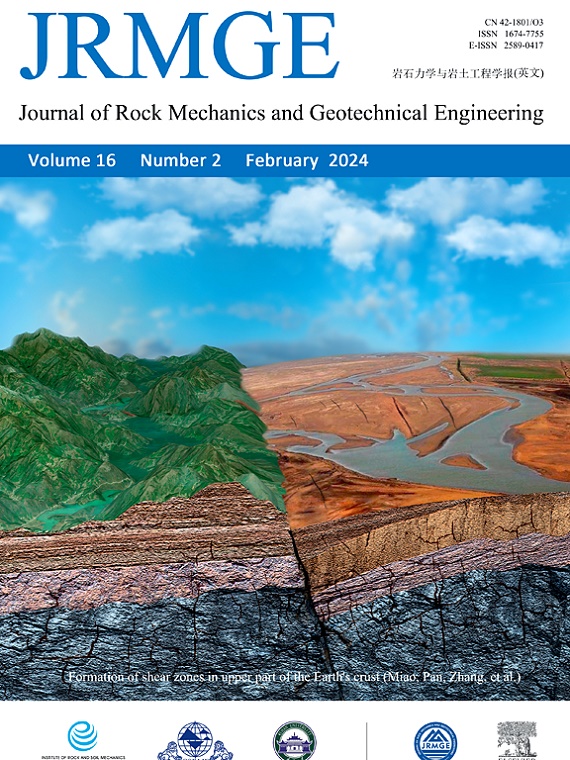基于微生物诱导的镁钙沉淀的生物胶结提高前滨坡抗潮汐侵蚀能力
IF 10.2
1区 工程技术
Q1 ENGINEERING, GEOLOGICAL
Journal of Rock Mechanics and Geotechnical Engineering
Pub Date : 2023-11-01
DOI:10.1016/j.jrmge.2023.08.009
引用次数: 0
摘要
在大多数沿海和河口地区,潮汐容易造成地表侵蚀甚至边坡破坏,造成严重的土地流失,沿海基础设施恶化,洪水增加。生物胶结技术已经被证明可以有效地提高斜坡的抗侵蚀能力。海水中镁离子(Mg2+)的浓度高于钙离子(Ca2+);因此,在本研究中,Mg2+和Ca2+以不同的Mg2+/Ca2+比例作为微生物诱导镁钙沉淀(MIMCP)处理,一起用于生物胶结。采用坡角、表面强度、析出物含量、主要相、析出物微观特征评价处理效果。结果表明,MIMCP处理显著提高了边坡的抗侵蚀能力。Mg2+/Ca2+比值降低,土壤角度变化较小,土壤流失量减少,特别是Mg2+浓度低于0.2 m时,Mg2+/Ca2+比值降低,降水含量增加,抗侵蚀能力增强,地表强度提高。此外,文石的生产将受益于升高的Mg2+浓度和较高的Ca2+浓度导致镁沉淀晶体中更多的nesquehonite。初始坡角为53°时,坡面抗侵蚀能力弱于初始坡角为35°时,但Mg2+/Ca2+比值为0.2:0.8、0.1:0.9和0:1.0对坡面稳定和缓蚀均有较好的效果。研究结果对应用MIMCP提高前滩边坡抗冲蚀性能具有重要意义,在海洋工程中具有广阔的应用前景。本文章由计算机程序翻译,如有差异,请以英文原文为准。
Bio-cementation for tidal erosion resistance improvement of foreshore slopes based on microbially induced magnesium and calcium precipitation
In most coastal and estuarine areas, tides easily cause surface erosion and even slope failure, resulting in severe land losses, deterioration of coastal infrastructure, and increased floods. The bio-cementation technique has been previously demonstrated to effectively improve the erosion resistance of slopes. Seawater contains magnesium ions (Mg2+) with a higher concentration than calcium ions (Ca2+); therefore, Mg2+ and Ca2+ were used together for bio-cementation in this study at various Mg2+/Ca2+ ratios as the microbially induced magnesium and calcium precipitation (MIMCP) treatment. Slope angles, surface strengths, precipitation contents, major phases, and microscopic characteristics of precipitation were used to evaluate the treatment effects. Results showed that the MIMCP treatment markedly enhanced the erosion resistance of slopes. Decreased Mg2+/Ca2+ ratios resulted in a smaller change in angles and fewer soil losses, especially the Mg2+ concentration below 0.2 M. The decreased Mg2+/Ca2+ ratio achieved increased precipitation contents, which contributed to better erosion resistance and higher surface strengths. Additionally, the production of aragonite would benefit from elevated Mg2+ concentrations and a higher Ca2+ concentration led to more nesquehonite in magnesium precipitation crystals. The slopes with an initial angle of 53° had worse erosion resistance than the slopes with an initial angle of 35°, but the Mg2+/Ca2+ ratios of 0.2:0.8, 0.1:0.9, and 0:1.0 were effective for both slope stabilization and erosion mitigation to a great extent. The results are of great significance for the application of MIMCP to improve erosion resistance of foreshore slopes and the MIMCP technique has promising application potential in marine engineering.
求助全文
通过发布文献求助,成功后即可免费获取论文全文。
去求助
来源期刊

Journal of Rock Mechanics and Geotechnical Engineering
Earth and Planetary Sciences-Geotechnical Engineering and Engineering Geology
CiteScore
11.60
自引率
6.80%
发文量
227
审稿时长
48 days
期刊介绍:
The Journal of Rock Mechanics and Geotechnical Engineering (JRMGE), overseen by the Institute of Rock and Soil Mechanics, Chinese Academy of Sciences, is dedicated to the latest advancements in rock mechanics and geotechnical engineering. It serves as a platform for global scholars to stay updated on developments in various related fields including soil mechanics, foundation engineering, civil engineering, mining engineering, hydraulic engineering, petroleum engineering, and engineering geology. With a focus on fostering international academic exchange, JRMGE acts as a conduit between theoretical advancements and practical applications. Topics covered include new theories, technologies, methods, experiences, in-situ and laboratory tests, developments, case studies, and timely reviews within the realm of rock mechanics and geotechnical engineering.
 求助内容:
求助内容: 应助结果提醒方式:
应助结果提醒方式:


